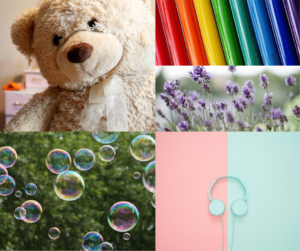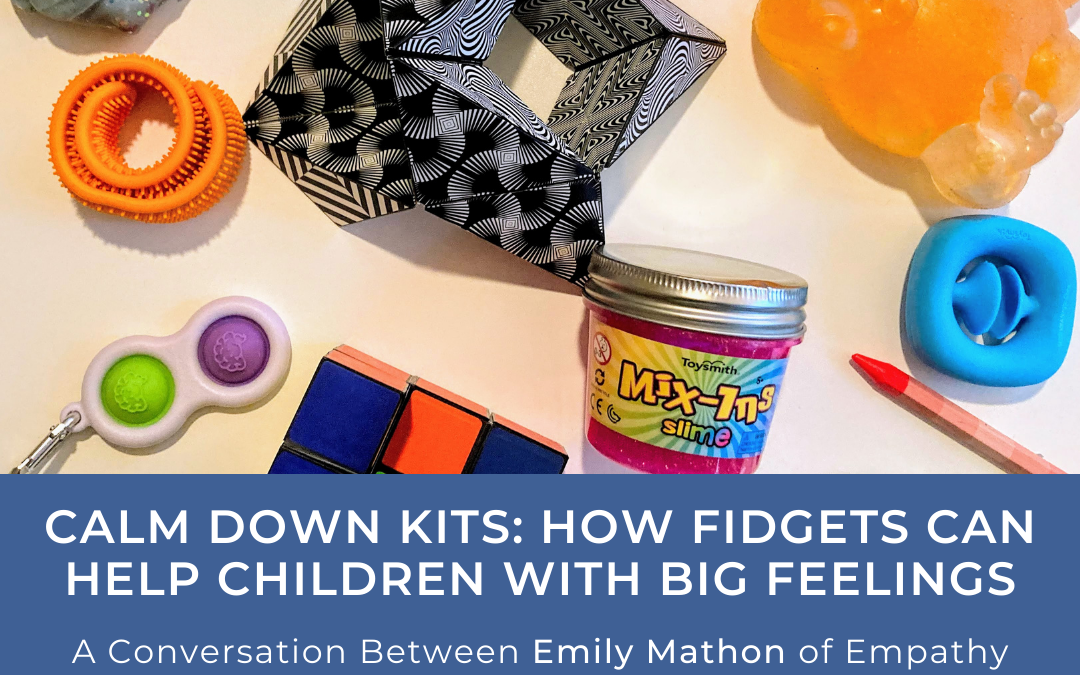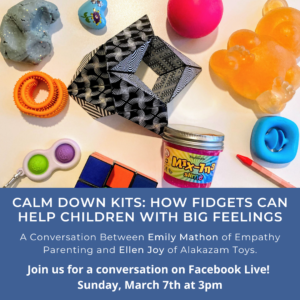When we, as adults, get flooded with emotions, whether anger, sadness, fear, worry, annoyance, or some other distressing feeling, what do we do? What do we need?
Likely, we nurture ourselves in some way, right?
- If we feel sad, we might call a friend, ask for a hug, write in our journal, or make a cup of tea.
- The times we feel angry, we might go for a walk, take some deep breaths, or sweep the floor.
- When we feel worried or stressed, we might stretch, listen to music, or meditate.
We, as adults, have developed (or are currently developing) these strategies over time. Calming and soothing ourselves is a life skill. Our children need our help with these strategies. So, how can we, as parents and caregivers, help our children?
Introduce Self-Calming
Prior to a blowout or high-stress moment, introduce the idea of self-calming. Prepare our children with a plan.
- Notice what our children find soothing or pleasing.
- Notice common triggers for an upset.
- Create a calming kit (more on that below) or calming space.
- Share and explain the calming kit/space at a friendly time.
- Create signals and signs as reminders.
When a stressful moment arises, use the following steps:
Step 1: Access our own calm. We will be able to provide support when we are relaxed. Read more on recharging and resetting in a previous blog.
Step 2: Acknowledge the big feeling by describing non-judgmentally what we observe.
- “I see____ are you feeling____?”
- “I notice___ are you _____?”
- Use an agreed-upon word, signal, or sign.
Step 3: Direct the child to the self-calming area or kit. Our children may need our quiet presence as they build their comfort with this practice.
Step 4: When they have calmed/when they are ready, invite expression of emotions, feelings, and worries.
Creating a Self-Calming Kit
When building self-calming kits, consider all of the senses: touch, smell, sight, hearing, taste, kinesthetic, and lack of stimulus. Some examples listed below are multi-sensory. Get the child’s input, notice what soothes them, and experiment a little. These items may change over time.
-
-
- Plush toy
- Soft blanket
- Warm bath/shower
-
- Smell
-
-
- Scented pillow: fill a sock with rice and essential oil
- Scented spray (lavender, orange)
- Clothing with parent’s scent
-
- Sight
-
-
- Books or magazines
- Glitter jar
- Blow bubbles
- Fish tank
- Window spot
-
- Sound
-
-
- iPod with music

- Music box
- Audiobook
- Noisemaker
- iPod with music
-
- Taste
-
-
- Lip balm
- Sugarless gum
- Drink water
-
- Kinesthetic
-
-
- Playdough, putty, or kinetic sand
- Squishy toy
- Exercises: yoga, jump, climb a tree, dance, bike, walk, kick a ball
- Crumple or tear paper
- Pop bubble wrap
-
- Lack of stimulus
-
- Breathe/Count breaths
- Guided meditation (Insight Timer & Headspace)
- Eye mask
Still have questions about creating a calming kit? Join me on Sunday, March 7th at 3 pm EST for a Facebook Live conversation with Ellen Joy, owner of Alakazam Toys in Charlottesville, as she shares some fabulous possibilities for building or adding to your calming kits. You can still watch the video even after the event has passed.
Alakazam Toys has created a limited supply of Calm Down Kits. You can browse them all here or if you know whether your child would like Look, Listen, Touch or Smell. All of these amazing self-calming kits are multisensory, accessibly-priced and already have a discount built-in. Connect with me to talk through what to possibly include in your kit.




Recent Comments